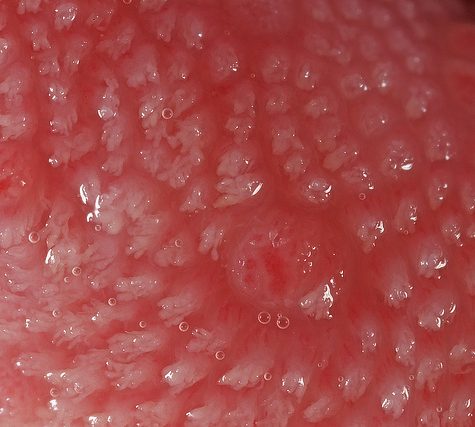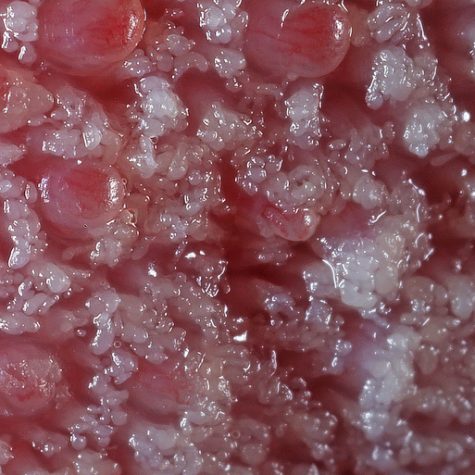Tongue
$19.00 – $400.00The tongue is a muscular organ in the mouth of most vertebrates that manipulates food for mastication, and is used in the act of swallowing. It is of importance in the digestive system and is the primary organ of taste in the gustatory system. The tongue’s upper surface (dorsum) is covered by taste buds housed in numerous lingual papillae. It is sensitive and kept moist by saliva, and is richly supplied with nerves and blood vessels. The tongue also serves as a natural means of cleaning the teeth.[2] A major function of the tongue is the enabling of speech in humans and vocalization in other animals.
Tongue
$19.00 – $400.00The tongue is a muscular organ in the mouth of most vertebrates that manipulates food for mastication, and is used in the act of swallowing. It is of importance in the digestive system and is the primary organ of taste in the gustatory system. The tongue’s upper surface (dorsum) is covered by taste buds housed in numerous lingual papillae. It is sensitive and kept moist by saliva, and is richly supplied with nerves and blood vessels. The tongue also serves as a natural means of cleaning the teeth.[2] A major function of the tongue is the enabling of speech in humans and vocalization in other animals.
Tongue
$19.00 – $400.00The tongue is a muscular organ in the mouth of most vertebrates that manipulates food for mastication, and is used in the act of swallowing. It is of importance in the digestive system and is the primary organ of taste in the gustatory system. The tongue’s upper surface (dorsum) is covered by taste buds housed in numerous lingual papillae. It is sensitive and kept moist by saliva, and is richly supplied with nerves and blood vessels. The tongue also serves as a natural means of cleaning the teeth.[2] A major function of the tongue is the enabling of speech in humans and vocalization in other animals.
Tongue
$19.00 – $400.00The tongue is a muscular organ in the mouth of most vertebrates that manipulates food for mastication, and is used in the act of swallowing. It is of importance in the digestive system and is the primary organ of taste in the gustatory system. The tongue’s upper surface (dorsum) is covered by taste buds housed in numerous lingual papillae. It is sensitive and kept moist by saliva, and is richly supplied with nerves and blood vessels. The tongue also serves as a natural means of cleaning the teeth.[2] A major function of the tongue is the enabling of speech in humans and vocalization in other animals.
Tongue
$19.00 – $400.00The tongue is a muscular organ in the mouth of most vertebrates that manipulates food for mastication, and is used in the act of swallowing. It is of importance in the digestive system and is the primary organ of taste in the gustatory system. The tongue’s upper surface (dorsum) is covered by taste buds housed in numerous lingual papillae. It is sensitive and kept moist by saliva, and is richly supplied with nerves and blood vessels. The tongue also serves as a natural means of cleaning the teeth.[2] A major function of the tongue is the enabling of speech in humans and vocalization in other animals.
Tongue
$19.00 – $400.00The tongue is a muscular organ in the mouth of most vertebrates that manipulates food for mastication, and is used in the act of swallowing. It is of importance in the digestive system and is the primary organ of taste in the gustatory system. The tongue’s upper surface (dorsum) is covered by taste buds housed in numerous lingual papillae. It is sensitive and kept moist by saliva, and is richly supplied with nerves and blood vessels. The tongue also serves as a natural means of cleaning the teeth.[2] A major function of the tongue is the enabling of speech in humans and vocalization in other animals.
Teeth
$19.00 – $400.00A tooth (plural teeth) is a hard, calcified structure found in the jaws (or mouths) of many vertebrates and used to break down food. Some animals, particularly carnivores, also use teeth for hunting or for defensive purposes. The roots of teeth are covered by gums. Teeth are not made of bone, but rather of multiple tissues of varying density and hardness. The cellular tissues that ultimately become teeth originate from the embryonic germ layer, the ectoderm.
Tongue
$19.00 – $400.00The tongue is a muscular organ in the mouth of most vertebrates that manipulates food for mastication, and is used in the act of swallowing. It is of importance in the digestive system and is the primary organ of taste in the gustatory system. The tongue’s upper surface (dorsum) is covered by taste buds housed in numerous lingual papillae. It is sensitive and kept moist by saliva, and is richly supplied with nerves and blood vessels. The tongue also serves as a natural means of cleaning the teeth.[2] A major function of the tongue is the enabling of speech in humans and vocalization in other animals.
Teeth Fluorescence
$19.00 – $400.00A tooth (plural teeth) is a hard, calcified structure found in the jaws (or mouths) of many vertebrates and used to break down food. Some animals, particularly carnivores, also use teeth for hunting or for defensive purposes. The roots of teeth are covered by gums. Teeth are not made of bone, but rather of multiple tissues of varying density and hardness. The cellular tissues that ultimately become teeth originate from the embryonic germ layer, the ectoderm.
Teeth Fluorescence
$19.00 – $400.00A tooth (plural teeth) is a hard, calcified structure found in the jaws (or mouths) of many vertebrates and used to break down food. Some animals, particularly carnivores, also use teeth for hunting or for defensive purposes. The roots of teeth are covered by gums. Teeth are not made of bone, but rather of multiple tissues of varying density and hardness. The cellular tissues that ultimately become teeth originate from the embryonic germ layer, the ectoderm.
Teeth Fluorescence
$19.00 – $400.00A tooth (plural teeth) is a hard, calcified structure found in the jaws (or mouths) of many vertebrates and used to break down food. Some animals, particularly carnivores, also use teeth for hunting or for defensive purposes. The roots of teeth are covered by gums. Teeth are not made of bone, but rather of multiple tissues of varying density and hardness. The cellular tissues that ultimately become teeth originate from the embryonic germ layer, the ectoderm.
Teeth Fluorescence
$19.00 – $400.00A tooth (plural teeth) is a hard, calcified structure found in the jaws (or mouths) of many vertebrates and used to break down food. Some animals, particularly carnivores, also use teeth for hunting or for defensive purposes. The roots of teeth are covered by gums. Teeth are not made of bone, but rather of multiple tissues of varying density and hardness. The cellular tissues that ultimately become teeth originate from the embryonic germ layer, the ectoderm.
Teeth Fluorescence
$19.00 – $400.00A tooth (plural teeth) is a hard, calcified structure found in the jaws (or mouths) of many vertebrates and used to break down food. Some animals, particularly carnivores, also use teeth for hunting or for defensive purposes. The roots of teeth are covered by gums. Teeth are not made of bone, but rather of multiple tissues of varying density and hardness. The cellular tissues that ultimately become teeth originate from the embryonic germ layer, the ectoderm.
Gums Fluorescence
$19.00 – $400.00Hair
$19.00 – $400.00Hair is a protein filament that grows from follicles found in the dermis, or skin. Hair is one of the defining characteristics of mammals. The human body, apart from areas of glabrous skin, is covered in follicles which produce thick terminal and fine vellus hair. Most common interest in hair is focused on hair growth, hair types and hair care, but hair is also an important biomaterial primarily composed of protein, notably alpha-keratin.
Attitudes towards different hair, such as hairstyles and hair removal, vary widely across different cultures and historical periods, but it is often used to indicate a person’s personal beliefs or social position, such as their age, sex, or religion.[1]
















